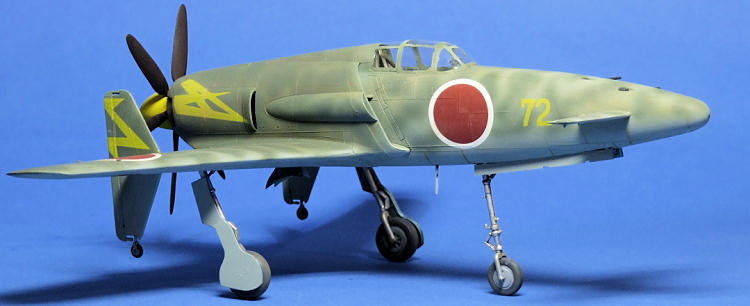
| KIT #: | 1189 |
| PRICE: | $15.00 (auction) |
| DECALS: | One option |
| REVIEWER: | Dale Rannals |
| NOTES: | Minicraft boxing |

| HISTORY |
The
“Alternate” History:
“It is a big ocean…..” Isoroku thought as the Shinden screamed over the
wave tops. He and his wingman left
Rabaul thirty minutes after the main attack group.
Being the damage assessment flight, they stayed low, cruising at 2000ft
until they spotted
Even though they stayed right above the trees, altitude continually
increased as they neared the Owen Stanley
mountain range. Once over
the rugged peaks they spotted smoke in the distance.
The strike force had marked their target nicely….fires were burning
fiercely at 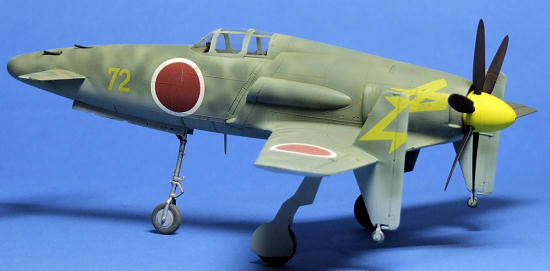 he
fuel stores. As they neared the
airfield he spotted a shape just above and in front of him.
It was an aircraft coming in to land…..a fighter, one of the big
Lockheeds. He smoothly nudged his
fighter up under the Chain Lightning.
Its rear gunner spotted him and began slewing his turrets around as
Isoroku pressed the button on his throttle and the four big cannon sounded off.
A few hits were all that was needed.
The big fighter lost a wing and tumbled out of control.
By the time it hit the ground Isoroku was already past the airfield.
Time to head home.
he
fuel stores. As they neared the
airfield he spotted a shape just above and in front of him.
It was an aircraft coming in to land…..a fighter, one of the big
Lockheeds. He smoothly nudged his
fighter up under the Chain Lightning.
Its rear gunner spotted him and began slewing his turrets around as
Isoroku pressed the button on his throttle and the four big cannon sounded off.
A few hits were all that was needed.
The big fighter lost a wing and tumbled out of control.
By the time it hit the ground Isoroku was already past the airfield.
Time to head home.
The pair turned northeast and left the area as fast as they came in.
Isoroku was, as always, impressed with their mounts.
The Shinden, ungainly and awkward looking on the ground, was magnificent
in the air. They would have never
had attempted this mission in the Hayabusa’s they flew just mere months ago… or
if they had, would already be dead.
Now their speed kept them alive in this hornets nest.
As they cleared the area Isoroku signaled his wingman to climb a few
hundred feet to make the trees a bit less menacing.
Starting he climb, he just about jumped out of his harness as two dark
shapes roared past just above them, heading south.
Leveling off, he turned slightly to get a look.
Two Republics…..the fast ones…. Ultrabolts.
Isoroku cursed himself for getting caught off guard ….that’s how you get
yourself killed. Apparently the
Americans were just as surprised as he, for it took a second before they
responded. He was hoping they would
just keep going; he really didn’t want to fight these two.
Getting back to base with his report was far more important. But as he
watched they began to turn back around.....Isoroku noticed one of them had a
jagged wingtip….damaged? It
would be a long chase, but the Republic fighter would catch them undoubtedly.
Halfway thru their turn they apparently had a change of heart and turned
back south. It seemed getting back
to base was important to them also.
With the Owen Stanley behind them and the coastline passing beneath them,
Isoroku breathed a small sigh of relief.
The ocean was always a danger…she was relentlessly unforgiving…. but at
least home was just a short time away.
The
Reality:
The J7W was developed for
the Imperial Japanese Navy as a short-range interceptor in a specific response
to the B-29 Superfortress raids on the Japanese homeland. For this type of
mission, the J7W was armed with 4 forward-firing 30mm cannons in the nose. It
was to be operated from land bases.
The canard configuration was
chosen by Captain Masayoshi Tsuruno from the technical staff of the Imperial
Japanese Navy in early 1943. The idea of Captain Tsuruno was that the aircraft
could easily be fitted with a turbojet engine in a later stage of its production
life.
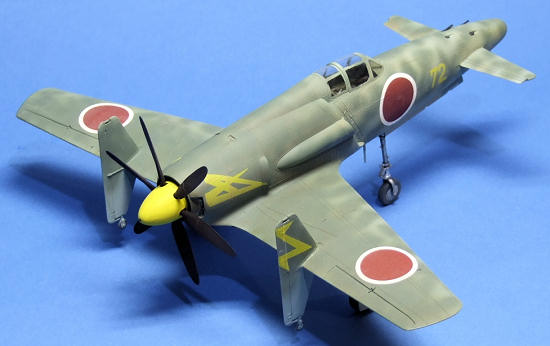 Captain
Tsuruno's ideas were worked out by the First Naval Air Technical Arsenal in
April 1943, by designing three gliders with the canard layout, designated
Captain
Tsuruno's ideas were worked out by the First Naval Air Technical Arsenal in
April 1943, by designing three gliders with the canard layout, designated
The feasibility of the
canard design was proven by both the powered and unpowered versions of the MYX6
by the end of 1943, and the Navy were so impressed by the flight testing, that
they instructed the Kyushu Aircraft Company to design a canard interceptor
around Captain Tsuruno's concept.
The construction of the
first two prototypes started in earnest by June 1944, stress calculations were
finished by January 1945. and the first prototype was completed in April 1945.
The 2,130 hp Mitsubishi MK9D (Ha-43) radial engine and its supercharger were
installed behind the cockpit and drove a six-bladed propeller via an extension
shaft. Engine cooling was to be provided by long, narrow, obliquely mounted
intakes on the side of the fuselage. It was this configuration that caused
cooling problems while running the engine while it was still on the ground.
This, together with the unavailability of some equipment parts postponed the
first flight of the Shinden until
Even before the first
prototype took to the air the Navy had already ordered the J7W1 into production,
with quotas of 30 Shindens a month given to
| THE KIT |
This is one of Hasegawa’s older
kits, easily 30 years old or so, with fine raised detail.
The kit has been re-released several times over the years with different
decals. There is also a J7W2 jet
version released recently…this is the same kit with resin intakes and
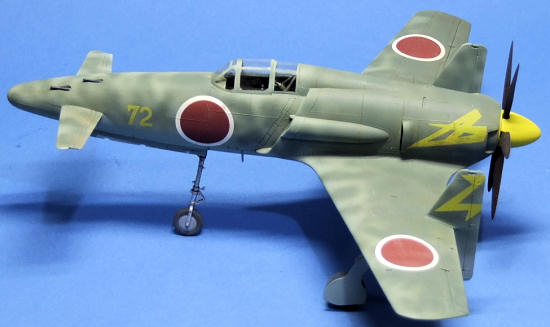 exhaust
pieces and an external stores sprue.
My kit was one of the earlier releases.
It was molded in dark green plastic, nice crisp detail and do flash to
speak of. The cockpit is well
detailed, especially for the time, and still holds up today.
In fact, I was very impressed with the over-all parts fit of this kit.
I could dry fit the nose to the fuselage pieces, attach the wings and
vertical stabs to it and hold the assembly up by one wingtip and it all stays
together. That’s pretty cool!
exhaust
pieces and an external stores sprue.
My kit was one of the earlier releases.
It was molded in dark green plastic, nice crisp detail and do flash to
speak of. The cockpit is well
detailed, especially for the time, and still holds up today.
In fact, I was very impressed with the over-all parts fit of this kit.
I could dry fit the nose to the fuselage pieces, attach the wings and
vertical stabs to it and hold the assembly up by one wingtip and it all stays
together. That’s pretty cool!
The instructions consist of four 8 ½ x 11 pages. The first page contains a small history with specifications, a complete parts list, and external colors with FS numbers. Pages two and three deal with seven assembly steps; all very clear with a fairly complete set of generic color call-outs. The last page has a final assembly step and a five view painting and decal guide. Decals are for the prototype, I assume, but in any case it is a very generic green over gray. My decals looked old, yellowed, and water damaged, so I tossed them away.
| CONSTRUCTION |
Construction started at the
cockpit, with several small sub-assemblies glued together and then painted a
dark olive green. I have no idea
what 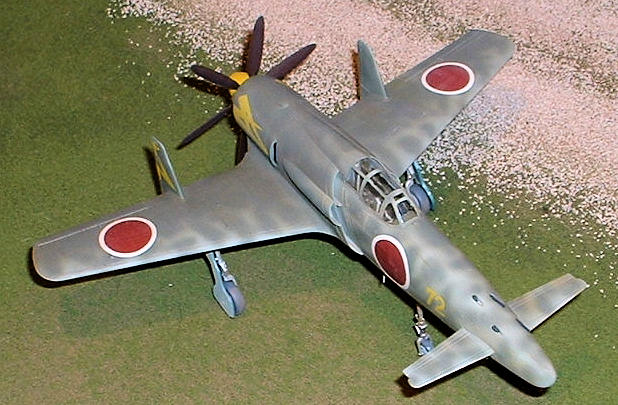 paint and
then a lighter gray dry-brushing to highlight the details. While these were
drying I glued together the main wings.
I then headed back to the cockpit
assembly, gluing together the components, adding some Eduard PE seat belts, and
gluing it to the fuselage.
paint and
then a lighter gray dry-brushing to highlight the details. While these were
drying I glued together the main wings.
I then headed back to the cockpit
assembly, gluing together the components, adding some Eduard PE seat belts, and
gluing it to the fuselage.
The fuselage halves were
joined and allowed to dry. Before I
added the canard/gun port insert to the nose, I mixed up some 5 minute epoxy,
poured some into the open nose, and added some lead weights (small fishing
sinkers) to keep this from being a tail dragger.
Then on went the insert. The
fit here is quite good, but not perfect.
I applied putty and surfacer to the joint lines here and along the
fuselage halves and sanded everything smooth.
As this is a raised panel line kit so you will lose detail here.
One needs to accept it or re-scribe.
Since I am not much into re-scribing, I moved on.
After I installed the fuselage side intakes, the wings were mated to the fuselage. A bit more puttying and sanding occurred. The engine fan was installed in the aft end. I built up the propeller, set it aside for painting, and then installed the rudders on each wing. Both were a nice tight fit with no alignment problems. I masked the canopy at this point and installed it on the airframe.
| COLORS & MARKINGS |
My inspiration here was the
paint scheme I had in mind. I had
seen pictures of Japanese fighters with what looked like lighter colors forward
but blending into a darker color aft.
I do believe the actual aircraft pictured could have been suffering from
late war issues of paint flaking off, with the dark green paint mostly gone from
the forward area of the plane, but it gave me the idea.
So for this attempt I decided
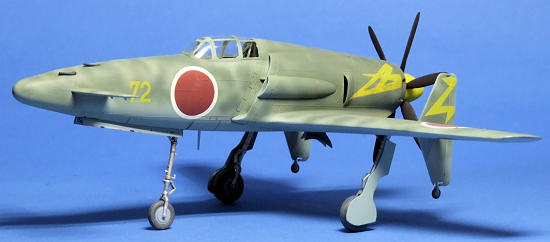 on IJN
green-gray base
with
IJA dark green mottling.
on IJN
green-gray base
with
IJA dark green mottling.
First color on
the plane was more olive green on the canopy frames.
I followed this with the IJN green-gray, spraying it on the entire plane.
Then I shot lighter and darker shades of the same paint on panel centers and
panel lines to give it some life.
The dark green mottling came next, and I did this in stages.
First pass was over the entire top of the airplane, giving it an even
overall pattern of green splotches.
After this came a second round of mottling, starting from the canards working
aft…i.e., I left the nose mottling as it was.
I continued in this fashion for about three more passes, each time
starting further aft than the last, and I also started decreasing the spacing
between mottles as I worked aft. I
was pleased when I finished as this gave me the effect I was looking for.
After a coat
of Future to gloss things up a bit, I scrounged the decal dungeon for suitable
markings.
They ended up coming from an
Aeromaster Hayate sheet (hinomarus) and the unit emblems from a Super Scale
sheet (I combined two different fighter group
emblems.) They weren't very
opaque, but it ended up giving it a grungier, weathered look.
| FINAL CONSTRUCTION |
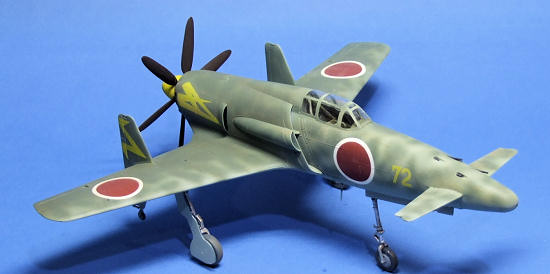
| CONCLUSIONS |
| REFERENCES |
May 2011
If you would like your product reviewed fairly and fairly quickly, please contact the editor or see other details in the Note to Contributors.